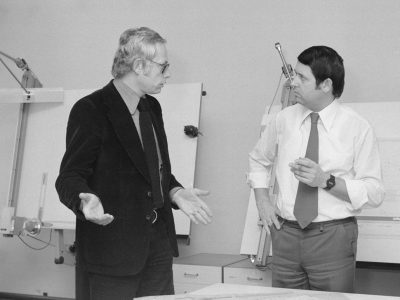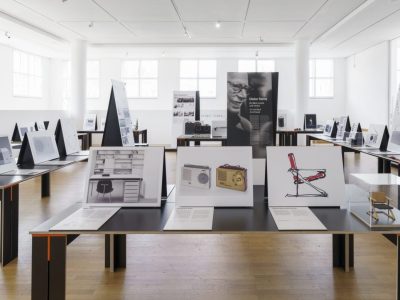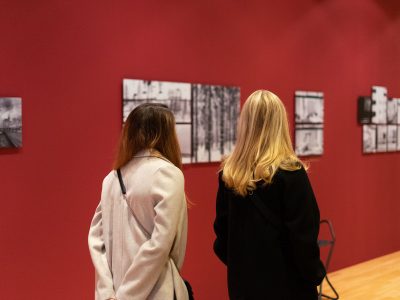

View of the exhibition, Museum Angewandte Kunst, Frankfurt a. M.
© Günzel/Rademacher
View of the Hi-Fi exhibits
Foto: Cassandra Peters © rams foundation
Dieter Rams. A Style Room
In Honour of Dieter Rams on His 85th Birthday
“Less, but better” – With his unpretentious, functional, visually long-lived and at the same time highly aesthetic products, Dieter Rams contributed to shaping the image of post-war German design. His approach still influences emerging generations of designers today. A passionate advocate of better and more sustainable design, Dieter Rams is considered one of the most successful and influential industrial designers of the twentieth century.
On the occasion of his eighty-fifth birthday, the Museum Angewandte Kunst is paying tribute to the designer with the opening of the Dieter Rams Style Room on Saturday, 20 May 2017 at 5:00 pm.
The new room on the museum’s second floor will feature changing exhibits to illustrate the interrelated aspects of content and biography that distinguish Dieter Rams’s approach to design. Important designs for Braun and the Universal Shelving System 606 will have as much a place here as a comfortable Rams lounge chair on which visitors are welcome to take a seat and page through catalogues and books. Two monitors will show photos of other Rams designs and the designer’s private residence. Models from the museum’s extensive collection will enhance selected works from the early phase of his career.
The Braun company has placed its model collection at the museum’s disposal as a permanent loan, and it is now undergoing scholarly investigation and appraisal in collaboration with Prof. Klaus Klemp of the HfG Offenbach University of Art and Design. In cooperation with the Dieter and Ingeborg Rams Foundation, the museum is also in the process of establishing an archive of the designer’s personal files and photographs.
Dieter Rams began studying interior decoration in 1947 at the Wiesbaden School of Arts and Crafts, whose founding director Hans Soeder had introduced elements of the Bauhaus teaching concept to the curriculum. After two years of employment with the Apel architectural firm (today ABB) of Frankfurt, Rams entered a position at the Max Braun company in 1955. At the time, the young heirs Erwin and Artur Braun were in the process of transforming the traditional company into a modern enterprise with an emphasis on social responsibility, and were in search of a new product language. On the ground prepared by the art historian Fritz Eichler, likewise a Braun employee, as well as the company’s cooperation with the HfG Ulm School of Design and the former Bauhaus pupils Wilhelm Wagenfeld and Herbert Hirche, the design team around Dieter Rams advanced to become an innovative centre of Braun’s dedication to design. Key aspects of their work were the early and extremely close cooperation with the company’s engineers and the constructive design process that came about as a result.
In the early 1960s, with Gerd A. Müller, Reinhold Weiss, Richard Fischer, Robert Oberheim and Dietrich Lubs on his staff, Braun design department head Dieter Rams developed a unique product language combining high functionality with visual longevity, intuitive operability and superb aesthetics. For devices ranging from hi-fi systems to electric razors, the team adopted a common design approach: the characteristic “Braun design”. Their concepts drew attention worldwide and came to be emulated by other companies and an emerging generation of young designers. Naoto Fukasawa, Jasper Morrison and Jonathan Ive, for example, all attest to the strong influence of Dieter Rams on their work.
Based on his own design praxis and ongoing critical reflection on his profession, Dieter Rams developed ten principles for good design: it has to be genuinely innovative, useful, aesthetic, understandable, honest, unobtrusive, thorough, long-lasting, intuitively operable and environmentally friendly. To this day, his creed is: “Good design is as little design as possible”, or simply “less, but better”. Longevity is a distinguishing feature of his modular furniture designs as well, some of which have been manufactured unchanged since 1960. The Vitsœ company in England still markets such products as the Universal Shelving System 606 or the Lounge Chair Programme 620 – one of the few design products ever awarded an artistic copyright – all over the world today. In the area of furniture, product cycles of such duration are otherwise known only for Thonet’s bentwood and tubular steel chairs or the designs by Ray and Charles Eames.
In addition to his own activities as a designer, Dieter Rams has made lasting contributions to improving design in general. He taught industrial design at the HfBK University of Fine Arts of Hamburg from 1981 to 1997, was president of the German Design Council from 1988 to 1998, and has been a member of the Academy of Arts in Berlin since 1999. In 1992, he and his wife founded the Dieter and Ingeborg Rams Foundation dedicated to promoting design with projects of its own. Dieter Rams is the recipient of numerous awards and distinctions, including the title of Honorary Royal Designer of the Royal Society of Arts, an honorary doctorate from the Royal College of Arts in London, the World Design Medal of the Industrial Designers Society of America, the Design Prize of the Federal Republic of Germany for lifetime achievement, and the Designer Award of the Raymond Loewy Foundation. He was also awarded the Order of Merit of the Federal Republic of Germany.
The MoMA in New York already began adding Braun products to its permanent collection as far back as 1959. Today works by Dieter Rams are in the holdings of nearly every design museum in the world. In 1980, the International Design Center Berlin organized the first extensive Dieter Rams exhibition; others have followed in such venues as Milan, London, Amsterdam, Fort Lauderdale, Lisbon, Kyoto, Moscow and, most recently, at vitra in Weil/Rhein. The exhibition “Less and More: The Design Ethos of Dieter Rams”, developed jointly by the Museum Angewandte Kunst in Frankfurt a. M. and the Suntory Museum in Osaka, opened in 2008. In the four years that followed, it was presented at six museums in Asia, Europe and the U.S., and over the course of altogether eighty-six exhibition weeks attracted more than 400,000 visitors.
Dieter Rams once said that “design is thinking” – putting in a nutshell the pursuit of better and more meaningful living environments by a reflective and critical designer who never conformed to fashion and always maintained a sense of responsibility towards the realm of products.
Director
Matthias Wagner K
Curator
Prof. Dr. Klaus Klemp
From the 2017 museum press release
More Contributions

10 Principles for Good Design
I expressed in ten principles the basic considerations that determine my work as a designer, and which represent the main features of my design philosophy.

A look back and ahead




